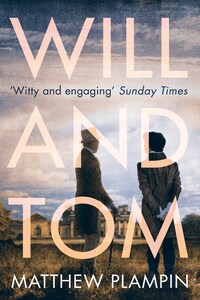The Borough Press
An imprint of HarperCollinsPublishers
1 London Bridge Street
London SE1 9GF
www.harpercollins.co.uk
Published by HarperCollinsPublishers 2015
Copyright © Matthew Plampin 2015
Cover layout design © HarperCollinsPublishers Ltd 2015
Cover images © Lee Lauren Matt LML Productions/Archangel Images (male figure on left and foreground grass); Richard Jenkins photography (male figure on right); Michael Hatfield/Alamy (background building).
Matthew Plampin asserts the moral right to be identified as the author of this work.
A catalogue record for this book is available from the British Library.
This novel is entirely a work of fiction. The names, characters and incidents portrayed in it, while at times based on historical figures, are the work of the author’s imagination.
All rights reserved under International and Pan-American Copyright Conventions. By payment of the required fees, you have been granted the non-exclusive, non-transferable right to access and read the text of this e-book on-screen. No part of this text may be reproduced, transmitted, down-loaded, decompiled, reverse engineered, or stored in or introduced into any information storage and retrieval system, in any form or by any means, whether electronic or mechanical, now known or hereinafter invented, without the express written permission of HarperCollins.
Source ISBN: 9780007560868
Ebook Edition © March 2015 ISBN: 9780007413935
Version: 2016-02-17
For KP,who made me think of golden aeroplanes
‘The enquiry in England is not whether a man has talents and genius, but whether he is passive and polite and a virtuous ass, and obedient to noblemen’s opinions in art and science. If he is, he is a good man: if not, he must be starved.’
WILLIAM BLAKE
In this period, watercolour paintings were commonly referred to as ‘drawings’, and watercolour brushes as ‘pencils’; this was partly to distinguish them from paintings in oil, which was considered the far superior medium. Artists who aspired to join the Royal Academy (the professional body that dominated British art until well into the nineteenth century) would often begin their careers exhibiting works in watercolour, proceeding to oil as their skills and reputations developed. When depicting landscape, the conventional approach was to make detailed open-air sketches in lead or graphite, before painting the actual watercolour in the studio. Simple colour studies were sometimes taken on the spot, but they tended to be crude, partial views, created for reference only. To depart from this method was highly unusual.
First sight of the house prompts a hard exhalation. Will’s fingers play a scale on the stick balanced over his shoulder. Sunlight swells between the scattered clouds, growing immensely bright, charging the pristine parkland around him with colour. His new blue coat feels hot and heavy; he notices the dampness gathering in his armpits and the droplets of perspiration wobbling on his freshly shaved lip.
‘Come now,’ he says. ‘Onwards.’
The driveway curves past a bank of elms and more of the vast mansion inches into view. Will smells bark and the resin oozing beneath; the leathery lushness of leaves; the faint, sour tang of livestock. He tries to calm himself by inwardly mapping out a composition and blending pigments to match the golden hue of the stone. The result of this exercise, unexpectedly, is disappointment. For all its size and grandeur, Harewood House is a simple structure, little more than an even line of boxes. There would be no challenge here.
Three large carts stand before the service entrance at the building’s eastern end. Servants are streaming in and out, unloading boxes, bags and packages. Mr Lascelles’ letter instructed Will to delay his arrival until a week into August, and here is the reason: that eminently fashionable gentleman has only just returned from London, despite the season having concluded some weeks previously. Will doesn’t try to imagine why this might be. Already, from his limited experience of their patronage, he’s learned not to second-guess the whims of the rich. A few glances are thrown his way – at his new clothes, his stick and bundle, the two leather-bound books clamped under his right arm – but no one asks his business. Their chief isn’t difficult to identify. A looming, fleshy fellow, clad in impeccable butler’s black, he watches from the sidelines, issuing orders and rebukes while doing none of the real work. Will steels himself and approaches. The man eyes him impatiently as he begins the introduction he rehearsed in the stage.
‘I have here a letter from Mr Lascelles, dated fifth of July, requesting that I attend him at—’
The butler, or whatever he is, breaks away to harass a pair of footmen bearing flat crates stamped with the mark of a London auction house – telling them to be extremely careful, that their positions are at stake and so on. Will follows, talking still, a strong, sudden indignation banishing any vestige of nervousness; and he crosses the threshold of the mighty house without even noticing.








